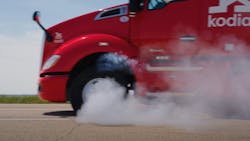Kodiak shows how its self-driving trucks handle tire blowouts
Kodiak Robotics has demonstrated that its autonomous technology can maintain control of a tractor-trailer when it suffers a catastrophic steer tire blowout while traveling at highway speeds. The self-driving trucking company, which said it is the first in the industry to achieve this milestone, showed off how this safety technology works in a video released Nov. 10.
Steer tire blowouts are among the biggest truck safety risks that can occur on the road, according to the National Highway Traffic Safety Administration. A front tire blowout instantly causes trucks to behave erratically and unpredictably, potentially resulting in a loss of control that can create roadway dangers.
Potential fleet customers had been asking Kodiak how its system handles edge cases, such as tire blowouts, Daniel Goff, head of policy at Kodiak, told FleetOwner. "This shows the progression of safety, which is about preparing for when bad things happen," he said.
Maintaining safe autonomous control
The Kodiak-produced video above shows a self-driving Class 8 tractor hauling a dry van roll over a test rig that punctures the front driver-side tire while the autonomous technology is engaged. After the tire is shredded and loses all its air pressure, the Kodiak Driver—the company's name for its autonomous trucking technology—stays in control and brings the truck to a safe and complete stop while maintaining its lane.
See also: Kodiak, Werner partner to run 24/7 autonomous long-haul freight
Kodiak chose to execute an in-lane fallback at its Texas proving grounds to not run a tireless truck wheel across the test track, Goff said. If a tire were to blow in a real-world setting, the truck would automatically execute its fallback plan, typically pulling it to a safe stop on the side of the road, according to Kodiak.
A safety benefit of Kodiak's self-driving technology is to instantly react to changes in vehicle dynamics, according to Don Burnette, company founder and CEO. In the case of the blown tire, the truck compensates for the failed tire by applying an entirely different steering angle. This exercise has been repeated multiple times and Kodiak truck's consistent ability to maintain its lane positioning illustrates the adaptability and control of the Kodiak Driver.
Here is the same test by Kodiak from multiple camera angles:
"We can't control the hazards trucks will face on the open road, but we can control how the trucks behave when a critical situation occurs," Burnette said. "By demonstrating that the Kodiak Driver can maintain complete control under such duress, we're showing the world just how safe this technology is designed to be."
Kodiak's fallback technology
The tire blowout demonstration relies on Kodiak's fallback technology, which guides its self-driving trucks to a safe stop in the event of a critical system failure. Upon experiencing the blowout, the autonomous system can immediately detect the tire fault, identify and adapt to the new vehicle dynamics, initiate the fallback protocol, trigger the hazard lights to turn on, and bring the truck to a stop within the lane. The speed of detection and level of control is critical for ensuring the safety of all motorists.
See also: Kodiak's 'Pilot' project will test autonomous truckports at travel centers
Ten times per second, the Kodiak Driver evaluates the performance of more than 1,000 safety-critical processes and components in both the self-driving stack and the underlying truck platform. These include truck-related components such as the engine, oil levels, tire pressure, and autonomous vehicle system components such as sensors and software processes.
If these critical components fall outside the acceptable performance parameters, the Kodiak Driver automatically executes a fallback plan, safely pulling the truck over to the side of the road. For example, if flying roadway debris were to damage one of the autonomous truck's sensors, the Kodiak Driver would detect the damage and safely pull the truck over.
"It's essential that the self-driving technology powering an 80,000-pound semi-truck is capable of reacting swiftly and safely, no matter what happens," Burnette said earlier this year. "Kodiak's autonomous trucks are constantly monitoring themselves and preparing to pull over in case of a fault, just like a human would. Kodiak's ability to perform safe fallbacks depends on our own custom-designed safety computer, the Actuation Control Engine, or ACE. One of the many crucial functions the Kodiak ACE is responsible for is ensuring that our autonomous system can guide the truck to a safe stop when necessary."
About the Author
Josh Fisher
Editor-in-Chief
Editor-in-Chief Josh Fisher has been with FleetOwner since 2017. He covers everything from modern fleet management to operational efficiency, artificial intelligence, autonomous trucking, alternative fuels and powertrains, regulations, and emerging transportation technology. Based in Maryland, he writes the Lane Shift Ahead column about the changing North American transportation landscape.

